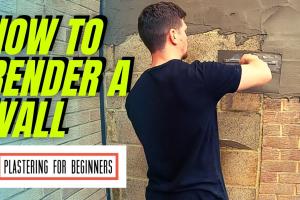Ultimate Guide to Rendering a Wall: Techniques, Tips, and Tools

-
Quick Links:
- 1. Introduction
- 2. What is Wall Rendering?
- 3. Types of Wall Rendering
- 4. Tools and Materials Needed
- 5. Preparing the Wall for Rendering
- 6. Step-by-Step Rendering Process
- 7. Finishing Touches
- 8. Maintenance of Rendered Walls
- 9. Case Studies and Examples
- 10. Expert Insights
- 11. FAQs
1. Introduction
Rendering a wall is an essential aspect of home improvement that enhances both aesthetic appeal and structural integrity. Whether you're looking to improve the exterior of your home or enhance interior walls, understanding how to render a wall correctly is crucial. In this comprehensive guide, we will explore the techniques, tips, and tools required to achieve professional results.
2. What is Wall Rendering?
Wall rendering refers to the process of applying a mixture of cement, sand, and water to walls, providing a smooth and durable finish. This process is commonly used in construction and renovation projects to protect walls from weather elements, improve thermal insulation, and achieve a decorative finish.
3. Types of Wall Rendering
There are several types of wall rendering techniques, each with its unique application:
- Cement Render: A mixture of cement and sand, best for external walls.
- Plaster Render: A mix of gypsum and water, ideal for interior walls.
- Acrylic Render: A polymer-based finish that provides flexibility and durability.
- Texture Render: Offers decorative finishes with various textures.
4. Tools and Materials Needed
To successfully render a wall, you will need the following tools and materials:
- Trowel
- Hawk
- Mixing bucket
- Cement and sand (or plaster mix)
- Paintbrush for applying bonding agents
- Float for smoothing
- Level for checking evenness
- Safety gear (gloves, goggles, mask)
5. Preparing the Wall for Rendering
The preparation phase is critical for achieving a successful render. Here’s how to prepare your wall:
- Clean the Surface: Remove any dirt, dust, or old paint.
- Repair Damages: Fill any cracks or holes with appropriate filler.
- Apply Bonding Agent: This ensures better adhesion of the render to the wall.
- Moisten the Wall: Wetting the surface before applying render helps prevent it from drying too quickly.
6. Step-by-Step Rendering Process
Follow these steps for a successful wall rendering:
Step 1: Mix the Render
Combine cement, sand, and water in a mixing bucket until you achieve a smooth, workable consistency.
Step 2: Apply the First Coat
Using a trowel, apply the first coat of render to the wall, ensuring even coverage.
Step 3: Level and Smooth
Use a float to level and smooth the surface, correcting any imperfections.
Step 4: Let it Cure
Allow the first coat to cure for at least 24 hours before applying the second coat.
Step 5: Apply the Second Coat
Repeat the process for the second coat, ensuring a thicker application for durability.
Step 6: Final Smoothing
Once the second coat is applied, use a sponge float to achieve a desired texture.
7. Finishing Touches
After rendering, consider adding a decorative finish or paint. This not only improves aesthetics but also provides additional protection against the elements.
8. Maintenance of Rendered Walls
Regular maintenance includes cleaning the walls, checking for cracks, and repainting as necessary. This will prolong the life of your render and maintain its appearance.
9. Case Studies and Examples
Let's look at some real-world examples of wall rendering projects:
Case Study 1: Residential Home
A family in a coastal area applied acrylic render to their external walls, significantly improving insulation and reducing energy bills.
Case Study 2: Commercial Building
A local business opted for textured render to enhance curb appeal, leading to an increase in foot traffic and customer interest.
10. Expert Insights
According to professional plasterers, the key to successful rendering lies in preparation and choosing the right materials. Always consult with professionals when in doubt, especially regarding weather conditions and material compatibility.
11. FAQs
Q1: How long does it take for wall render to dry?
A: Generally, it takes about 24 to 48 hours for the render to dry, but full curing can take up to 28 days.
Q2: Can I render over painted walls?
A: Yes, but it's essential to prepare the surface properly by cleaning and possibly sanding it down to ensure adhesion.
Q3: Is rendering suitable for all types of walls?
A: Rendering is suitable for most masonry walls but may not be ideal for surfaces like wood or metal.
Q4: How thick should the render be applied?
A: Typically, a thickness of 10-20mm is recommended for most applications.
Q5: What is the best time of year to render?
A: Spring and autumn are ideal, avoiding extreme temperatures and wet conditions.
Q6: Can I paint over rendered walls?
A: Yes, once the render is fully cured, you can paint it with exterior or interior paint.
Q7: How do I know if the render has cracked?
A: Regular inspections for visible cracks or flaking can help identify issues early.
Q8: Can I do it myself?
A: Yes, with the right tools and preparation, DIY wall rendering is achievable for homeowners.
Q9: What's the cost of rendering a wall?
A: Costs can vary widely based on materials and labor but typically range from $30 to $100 per square meter.
Q10: How can I prevent mold on rendered walls?
A: Ensure proper drainage and ventilation, and consider using mold-resistant materials.
Random Reads
- How to remove replace thermal paste cpu
- How to open wordpad windows 10
- How to make a user account an administrator in windows 8
- How to open master lock without code
- How to open nintendo switch kickstand
- How to make an armor stand in minecraft
- Mastering photoshop creating psd files
- How to size a radiator
- How to sign in icloud itunes app store iphone
- How to update sound drivers